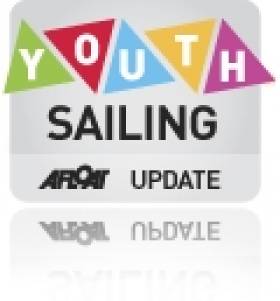Displaying items by tag: Jamie Donegan
#fastnet race – This year's 90th anniversary edition of the mighty Fastnet Race on August 16th will see a record fleet including two of the world's very newest maxis – Jim & Kristy Hinze Clark's 100ft Comanche and George David's exceptionally quick 88ft Rambler 88 - lining up against the likes of Mike Slade's veteran 100ft Leopard, which took line honours in 2007 and 2009.
In addition to the demands of racing, they're taking on a challenge of rugged sailing which George David knows only too well, as his Rambler 100 capsized at the Fastnet Rock itself in 2011's race after losing her canting ballast keel.
Whether with canting keels or using more orthodox methods of stability provision, the astonishingly varied 350-plus international fleet will be celebrating a great course and a major event which is now central to the panorama of world sailing. It is difficult to imagine the global sailing programme without the Fastnet Race in its biennial position of major importance. Yet getting it up and running in 1925 was a dogged struggle, worked through amidst fierce controversy.
And in contrast with today's large and totally international fleet, the "founding flotilla" was just seven boats, while the nearest it could claim to having an international element was through the presence of the 43ft cutter Gull from Cork. In unveiling Gull's distinctive contribution to the establishment of the Fastnet Race, W M Nixon begins by introducing us to an American description of Gull and her skipper. This colourful piece first appeared in a sailing magazine after the second Fastnet Race of 1926, and then achieved immortality by being included in Alfred F Loomis's seminal book Ocean Racing, first published 1936.
"The Gull was a plank-on-edge cutter of ancient vintage. She had a tremendous jackyard topsail, a terrific tiller, and a pack of wild Irishmen aboard her, who flogged the life out of her. As I recall, we were either first or second around the Fastnet. Shortly thereafter the mainsail started letting go and water came up over the floorboards because we'd spewed all our bow caulking. The glass dropped .80 inches in forty-five minutes, and on that came a regular Bristol Channel howler. In thick weather we groped for Baltimore, and when we got within what we estimated to be two miles and could not pick up the light, we reluctantly gave up the heroic idea of beaching the Gull there, caulking her, and still finishing. (Yes, that's the sort of skipper and crew it was!)
We hauled up for Cork Harbour, close-hauled under tri-sail and storm jib with the wind coming down now from about Sou'east, and that delightful Irish coast altogether too close under our lee. The seas were breaching clean over the old packet, and the spitfire jib – though we didn't know it – was pulling the runner eyebolt right out of the counter. We passed the Stag Rocks and they weren't more than two hundred yards to leeward; on the darkest, wildest sort of night they were plainly visible and audible, great and terrifying founts of spray just to leeward. This was possibly the closest escape I've ever had at sea, and one of the few times my life has actually been in danger.
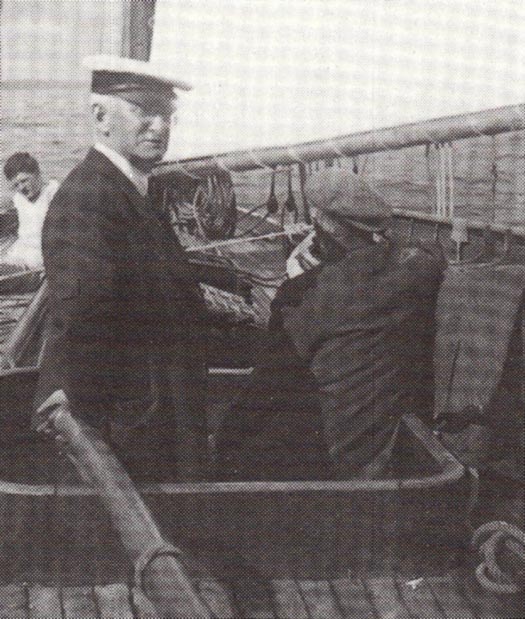
It was certainly no exaggeration to describe her as being steered with a "terrific tiller" - Harry Donegan on the helm.
Well, the old bucket held together until we put her on the mud at Crosshaven in the morning. All hands had pumped, bailed and cursed – I didn't hear any praying – all night long, and everything aboard was soaked.
While the mess was drying out in the sunlight this final morning I found my bedraggled, red-eyed, but still spunky little skipper fiddling around on deck with what to me looked suspiciously like a boy's toy. I asked him what he was doing, and his answer, s'helpmegawd, was,
"I'm flying a kite."
He went on to explain that he had meant to test out a theory that an aerial could best be carried by a kite when at sea, and so he had brought along a box-kite which had been forgotten until we started heaving the gear on deck. Discovering it at this late date, his intellectual curiosity remained strong enough to overcome the anxiety, desperate work and weariness of a rotten hard race and near-foundering.
His name is Henry P F Donegan, a solicitor of Cork, and he is one of the world's best."
Thus we have Harry Donegan and his beloved Gull, vividly remembered for all time in international sailing history. The piece may have several inaccuracies and any amount of poetic licence. But there's no doubting how it captures the spirit of a man who, with maybe just two or three others - if others there were at all – was present at both the founding of the Royal Ocean Racing Club in Plymouth at a dinner in the Royal Western Yacht Club on August 23rd 1925 after the finish of the first Fastnet Race, and at the founding of the Irish Cruising Club at a dinner in Glengarriff on July 13th 1929 after a Cruise-in-Company in West Cork. On both occasions, he had sailed there aboard Gull.
This particular account of a "rotten hard race and near-foundering" is about the second Fastnet Race of 1926, which was the first to start from Cowes. The first and decidedly controversial Fastnet Race of 1925 had only been able to secure a start from the Royal Victoria Yacht Club at Ryde, which sent the fleet out of the Solent eastabout.
The colourful yarn about the 1926 race was written by the American Warwick Tomkins, who had done a pierhead jump aboard the Irish boat at almost the last minute, and his impressions of Gull were perhaps slightly skewed. For sure, she certainly did have a "terrific tiller". Yet as she was built in 1896, she was only thirty years old at the time, which was scarcely "ancient vintage". As for being "plank-on-edge", that almost amounts to defamation - she had a beam of slightly over 10ft on an overall length of 44ft, which made her decidedly beefy by comparison with the true plank-on-edge lead-mines of the 1870s and 1880s.
In fact, Gull was a classy performance cruiser built by Camper & Nicholson at Gosport, and designed by a rising star in the family firm, Charles E Nicholson, who was twenty-eight when she was launched. But she set such an enormous spread of canvas that her shroud base had been widened by the use of channels, an archaic system which may have heightened her apparent antiquity for American eyes.
However, the "tremendous jackyard topsail" was if anything an understatement. The luff of this extraordinary sail was something like 50% longer than the luff of the mainsail. The idea of carrying - let alone sending aloft - this vast acreage of sail with its two long and heavy yards in open ocean seemed an appalling notion to conservatives who had doubted the wisdom of an "ocean race" from the very beginning.
And in truth it still seems an appalling notion to us today, with our roller furling sails and all conveniences. For us, Gull seems the epitome of labour-intensive danger-laden sailing, and in the fleet of just seven which raced in the first Fastnet, she was the only one which had any claims to be "yacht-like" – all the rest were variants on no-nonsense sailing working boats, with the eventual winner Jolie Brise being a 1913-built sailing pilot cutter which had worked out of Le Havre.
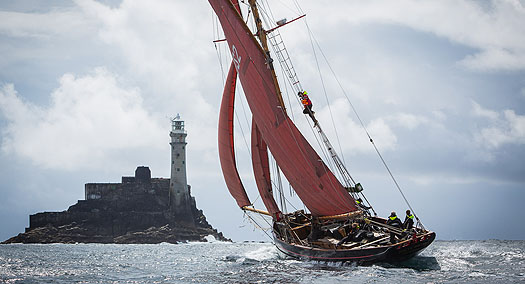
The winner of the first Fastnet Race was the former pilot cutter Jolie Brise, seen here at the fastnet while celebrating her Centenary at the Glandore Classics Regatta 2013. Photo: Brian Carlin
Failure is an orphan but success has many father, and with the 90th Anniversary Fastnet Race coming up in August with its record entry, the analyses are becoming ever more detailed in allocating the true credit for this first "Corinthian ocean race" in European waters.
In doing so, we are immediately into the problems of defining just what is meant by an "ocean race". After all, one of the earliest - if not the first - offshore distance races anywhere was from Dublin Bay to Cork Harbour, and it was sailed as long ago as 1860, the winner by a whisker being the amateur skipper Henry O'Bryen sailing the 39-ton cutter Sybil.
Then, in the final decades of the 19th Century, there were two or three Tranatlantic races – true ocean races - for enormous yachts sailed by professionals. But even though one started and another finished at Cork Harbour, they weren't seen as something to which Corinthian sailors could relate. In fact, one of the first relatively regularly-staged and truly oceanic races with amateur input was from California across the Pacific to Hawaii, inaugurated in 1906, but somehow the Transpac didn't receive the attention it deserved, possibly because it was sailed on warm water between places a long way from the true ocean – the Atlantic.
There, much more attention focused on the first Bermuda Race from New York, also in 1906, despite it having only three entries. But that had grown to twelve by 1907, yet it had fallen back to just two in 1910. The First World War intervened, then there wee two low-key revivals in 1921 and '22, but eventually in 1923 there was a serious move to revive the Bermuda Race, and the newly-formed Cruising Club of America took it under its wing. There were 22 entries, and since 1924 the 635-mile Bermuda Race has been an established biennial ocean classic.
However, in the higher latitudes and colder water of Western Europe, the yachting establishment centred around the Solent was very wary of such things. The attitude was that racers shouldn't go on the ocean, while boats fit to go on the colder parts of the ocean were incapable of meaningful racing.
But some disagreed. George Martin (1881-1945), a leading younger member of the Royal Cruising Club since 1905, was in favour of fast sailing, though it was just one of his many boat-centred interests. His family had founded Martin's Bank, while he had been awarded the RCC's premier trophy, the Challenge Cup, two years running in 1907 and 1908. These had been for intrepid ventures with a 35-ton 1903-built gaff cutter called Chance, one from his home waters in south Devon to Gibraltar and return, the other a circuit of Denmark from the same starting point, with Norwegian, Swedish and German ports being visited en route.
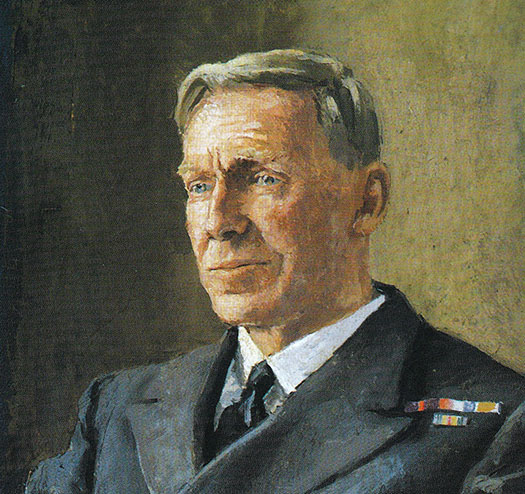
Lt Cdr George Martin OBE (1881-1945), founding Commodore of the Royal Ocean Racing Club and winner of the first Fastnet Race
Both cruises were made in fairly determined style, and Martin – a well-liked and gangling sort of man 6ft 7ins in height - had something of a reputation as a skipper who liked to push his boats to best performance. But when, eleven years later and shortly after he'd served in the RNR with distinction throughout the Great War, he began to make noises in favour of the RCC staging an "ocean race", he was rebuffed.
Things get a bit murky at this stage, as we can only go on the official club minutes, which often give a sanitized version of events. But what we do know is that in 1919 George Martin was put forward for Rear Commodore of the RCC by two very distinguished members, the maritime writer E Keble Chatterton and the already well-known cruising man George Muhlhauser, who soon afterwards was to make was to make a global circumnavigation with the 37-ton yawl Amaryllis for which he, like Martin in 1907 and 1908, was to be awarded the Challenge Cup in 1921 and 1922 (followed incidentally by Conor O'Brien with Saoirse in 1923, 24 & 25, but that's another story altogether).
Meanwhile in 1919, the possibility of the revolutionary George Martin with his wild notions of ocean racing becoming part of the RCC hierarchy seems to have caused considerable fluttering in the dovecotes of the serious cruising establishment, and Donald Cree – who had been Honorary Secretary of the RCC since 1908 but was under temporary replacement by his father Charles while he saw out his wartime service - stood against George Martin.
Despite the distinction of his proposers, Martin was roundly defeated by 129 votes to 49. The anti-ocean-racing mood of the club was clear. And as the RCC History (published for the club's Centenary in 1980) puts it: "Only a year later, and after a great deal of exertion on his part to become Rear Commodore, Cree resigned the office and again became Honorary Secretary. He was to be Honorary Secretary for the next 43 years, until 1964; in all he held the post for 52 years."
George Martin being a decent and well-liked man, he went on to do what he saw as the decent thing if he wished to persist in promoting ocean racing - he resigned from the Royal Cruising Club in 1921. However, he was Commodore of a Devon-based yacht club, the Royal South Western in Plymouth which was in process of amalgamating with the more senior Royal Western Yacht Club in the same port, of which in due course he became Commodore. This gave him some organisational muscle for further promotion of ocean racing.
By 1923 he had replaced the hefty Chance with a flying machine, the former Le Havre pilot cutter Jolie Brise. Built in 1913 and one of the last significant sailing pilot cutters built anywhere, her retirement from active work had been hastened by the accelerated technical advances in steam-driven seagoing vessels during the Great War. By 1917, Jolie Brise was redundant at Le Havre, and until George Martin took her over in 1923, her fate was uncertain as she had been of only limited use as a fishing boat.
Cometh the hour, cometh the man, cometh the boat. George Martin with the Jolie Brise needed a race of more than 600 miles from the Solent across the Western Approaches and back to Plymouth simply to express themselves. But despite his huge size, Martin was by nature diffident, and the most direct promotion for an ocean race in British waters came from a new direction entirely.
Enter offshore sailing enthusiast Joseph Weston Martyr (1885-1966), a former officer of the British army in the worst of the World War I trenches. He had worked post war in New York as a ship broker, but then took to maritime writing as a fulltime career while staying in America. In 1922, 1923 and 1924 he sailed in the Bermuda Race, the third time being aboard the schooner Northern Light. Although an error by the navigator meant they were totally last by the time they found the finish line, his enthusiasm was fired up, and he started bombarding British yachting magazines with ideas for an event of similar length on their side of the Atlantic.
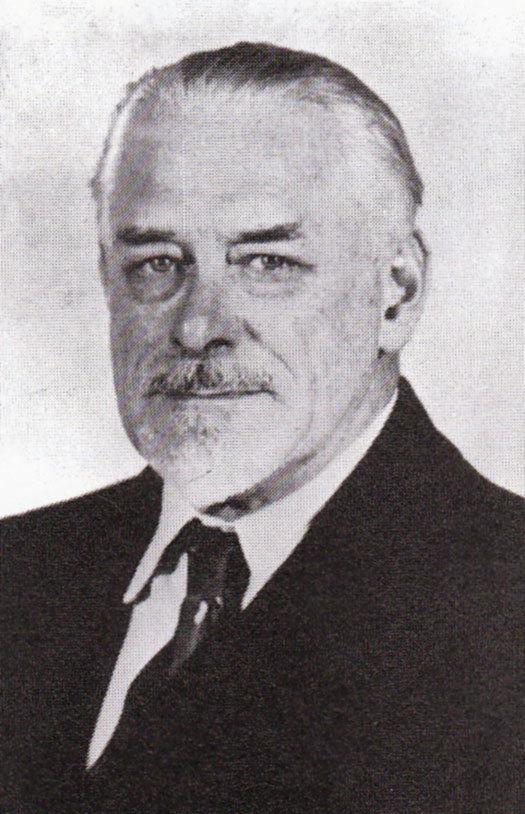
Weston Martyr, whose journalistic enthusiasm for ocean racing encouraged the movement towards establishing the Fastnet Race. He is equally well remembered for his classic of sailing literature The Southseaman – the Life Story of a Schooner (1926), a partially fictionalised yarn built around his experiences with the schooner Northern Light.
Both Yachting Monthly through its editor, and Yachting World through its publisher, got involved in the growing interest, so when cruising's most respected authority, Claud Worth the Vice Commodore of the Royal Cruising, felt obliged to comment, he did so in the pages of The Field. Worth had been upset by George Martin's resignation from the RCC, and a small part of him inclined to ocean racing, for he was no slouch in getting performance out of his own boats. But he was concerned that in the heat of competition, even the most sensible amateur seamen would drive their boats too hard downwind, and he wrote:
"At the risk of making an unpopular suggestion, I venture to express a doubt which arises in my mind – are our latitudes suitable for a public ocean race?......a public race might well include some owners whose keenness is greater than their experience. If the weather should be bad, so long as there is a headwind they would probably come to no harm, for a good boat and sound gear will generally stand as much driving as the crew can put up with. But when running before anything approaching a gale of wind in a big sea in open water, conditions are very deceptive......".
Yet by early 1925 the momentum towards a race round the Fastnet seemed almost unstoppable, so as a final input to the debate, Worth suggested that if an ocean race was indeed going to be held, then it should be a true ocean event clear of the hazards of skirting any coastline, taking the fleet from the south coast of England to northwest Spain. He even offered to sail out to La Coruna or Vigo to time the boats in at the finish.
However, a small private Ocean Race Committee had been formed by George Martin, Weston Martyr recently back from America, and Malden Heckstall-Smith, the Editor of Yachting Monthly, and the course was set from the Solent to the Fastnet and thence to the finish at Plymouth. The Morning Post of 7th March 1925 announced that "the Ocean Race shall be.....sailed under the flag of the Royal Western Yacht Club". Four entries were in before the month was out, and at one stage around July1st the list of potential competitors ran to fourteen boats, including an American yawl which promised to bring an international flavour.
But in the end, on August 15th just seven started, and Harry Donegan's Gull from Cork was the nearest thing to international involvement, though she was scarcely thought of as such, as the British yachting establishment at the time would have reckoned that the Irish Fee State was only a temporary aberration.
As to whether there was any prior friendship between Harry Donegan and George Martin to encourage Gull's participation, at the moment we can only guess. George Martin had family connections in Ireland, and at one stage he was reportedly a member of the Royal St George Yacht Club. And like many other RCC members, he seems to have been familiar with the coast of southwest Ireland, and the selection of the Fastnet as the key turning mark in the new ocean race was his choice.
But although Harry Donegan was producing his own chartlets and sailing directions for the best anchorages in Ireland's southwest, and he also regularly cruised to southwest England, letters exchanged after the first Fastnet Race suggest that he and George Martin had never met before it. It was simply Harry Donegan's readiness for a good sailing challenge which drew him in.
And when the first Fastnet Race finally got under way, he was very likely the only skipper who had actually raced round the rock before. Schull Regatta had been in being since 1884, and though most sailors in Cork Harbour thought of the "ocean race" as being the annual jaunt round to Kinsale at the height of the summer, the more intrepid such as Harry Donegan had been known to race to Schull via the Fastnet.
So who was he, this Cork solicitor whose support for George Martin and Weston Maryr in their notion of a long offshore race round the Fastnet helped to launch it into a progression which has led to this year's mega-event 90 years down the line?
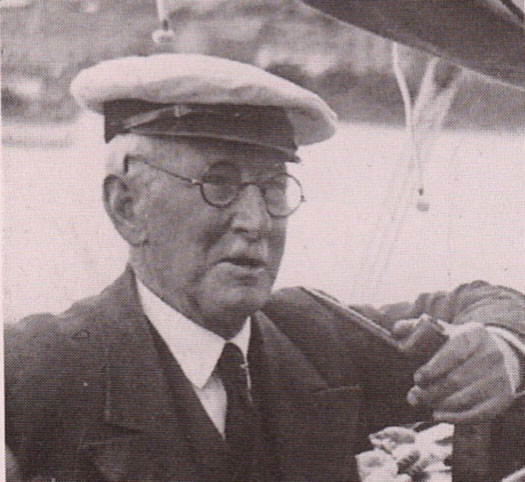
Henry P F Donegan (1870-1940), who gave his total support for the Fastnet Race from its inception in 1925.
Henry P F Donegan (1870-1940) was in his way quite a force in sailing, and in the life of Cork and Ireland. A small man of notable energy sharpened by being a teetotaler, he was playing a key role in Cork Harbour sailing from an early age. When the plans for the new Cork Harbour One Designs were being discussed with William Fife in 1895-96, Donegan was secretary to the owners' group, and though he never owned a CHOD himself, he was renowned as a helmsman in the class, and as an amateur painter he also recorded their earliest appearances.
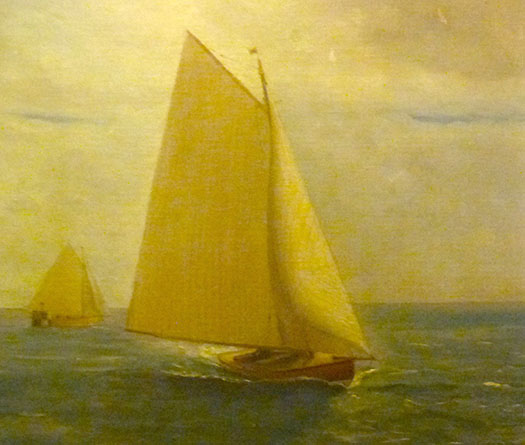
Cork Harbour One Design as painted by Harry Donegan. Although never an owner in the class, he was secretary to the class association at its foundation in 1896, and was noted as a very able CHOD helmsman.
But cruising and offshore sailing were his greatest passion, and he made some coastal ventures in very small craft. By 1912 he had produced pioneering harbour and anchorage plans for the magic places of West Cork, and this early interest in sailing directions was part of his enthusiasm for the notion of an Irish Cruising Club, though it was 1929 before he and a friend met while cruising West Cork, Billy Mooney of Howth, were finally able to bring the ICC into being.
Back in 1920 meanwhile, the Cork Harbour cruiser fleet had acquired a handsome addition, the 18-ton Nicholson cutter Gull, bought in the southwest of England. For some reason, whoever brought her to Cork had to sell her the following year, and thus in 1921, Harry Donegan acquired his dreamship, the sailing love of his life.
These were difficult times in Ireland, with the country emerging from the War of Independence only to be plunged into the Civil War of 1922, fought over the acceptance or rejection of the Treaty which had ended the War of Independence. Initially, the anti-treaty forces had control of Cork, but as the summer of 1922 progressed, the Government's pro-treaty forces under the command of Emmett Dalton gradually closed in to free the southern capital.
Communications between Dalton and his commander Michael Collins in Dublin were becoming increasingly difficult as roads, railways and telegraph lines between the two cities were disrupted by anti-treaty guerilla groups. A system had been worked out whereby communications between Dalton and Collins were carried personally by Collins' feisty sister, Mary Collins-Powell. But when all the usual means of getting her to Dublin with the vital dispatches were finally gone, Harry Donegan – who had been the leader of the pro-Home Rule Redmondite Party in Cork though not himself an active politician - offered to sail Collins' sister aboard Gull to Rosslare Harbour, where the east coast railway was firmly under government control all the way to Dublin.
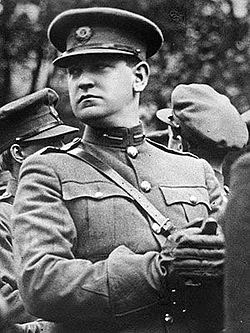
Michael Collins, Commander-in-Chief of the Government Forces after Independence. As the Civil War built to its climax in West Cork in 1922, Harry Donegan carried despatches aboard Gull from the Government forces in Cork for Michael Collins at HQ in Dublin, as rebel guerillas had cut off all other lines of communication.
For this venture in early August 1922, he assembled a crew of several professional talents. Harry Donegan was a solicitor, his first mate was Dr Gerald Ahern the local doctor, and in their sailing and any spiritual needs, they were helped by the third crewman, Father Donal Murphy O'Connor.
Easterly winds hampered their progress towards Rosslare, but fortunately Government-controlled Waterford offered taxi communication with Rosslare, so they peeled off into port and soon Mary Collins-Powell and the dispatches were in Dublin and Gull cruised back to Crosshaven. With the situation clarified for the general staff in Dublin, plans could be finalized for the freeing of Cork, and Emmett Dalton and his men soon had the job done.
Which was just as well for our three heroes on the Gull. While the city may have been coming rapidly under Government control, close to the south the countryside was still full of anti-treaty units. It was Civil War in all its horror of brother against brother, friend against friend. When the crew of Gull came ashore in Crosshaven after their successful little voyage, they were promptly captured by a local anti-treaty group, and imprisoned for some days in a shed.
But up in Cork, Emmett Dalton and his fellow commanders were going about their business with such efficiency that in Crosshaven the solicitor, doctor and priest - sailors all - were soon released unharmed. Peace returned to Cork Harbour. But as the main theatre of the Civil War moved ever more remorselessly towards its bloody denouement in West Cork, Michael Collins felt he could no longer be up in Dublin, remote from events in his home county.
Despite everyone else advising against it, he came to Cork to be with his men. He spent his final night in the Imperial Hotel in Cork, and with that city already showing signs of its civilized normality, who knows but he may have had time to meet up with Harry Donegan, for everyone in Cork knew everyone else, then as now.
Next day, the Commander-in-Chief headed west on his tour of inspection, and by evening General Collins was dead, killed during a spirited exchange of fire in which he personally got involved following an ambush by men who would have been his comrades-in-arms during the War of Independence.
The Civil War was already being won by the pro-Treaty forces, but the death of Collins undoubtedly speeded its ruthless conclusion, which included the government execution in November of Erskine Childers, another noted sailing man who had become embroiled in the Troubles. By 1923, Ireland was very determinedly getting back to normality.
In its own way, sailing made its contribution. In Dublin, self-taught yacht designer John B Kearney started construction on his masterpiece, the 38ft yawl Mavis. From Foynes on the Shannon Estuary, Conor O'Brien departed in his 42ft ketch Saoirse – newly-built to his own design in Baltimore, West Cork - to sail to Dun Laoghaire to begin what was to become his epic pioneering voyage, round the world in two years south of the great Capes.
And in Crosshaven, Harry Donegan kitted out the Gull to make a long cruise to the west coast of France which so clearly demonstrated the yacht's speedy sea-keeping ability that when, towards the end of 1924, the notion was first being aired of the new 630 mile ocean race from the Solent out to the Fastnet Rock, then back to a finish at Plymouth, he was soon keen to get involved and - unlike some others - he maintained his enthusiasm and was there for the starting gun.
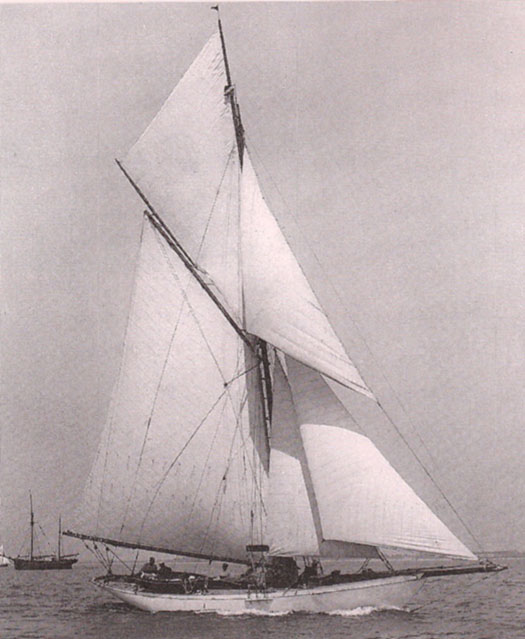
Gull at the start of the first Fastnet Race, August 15th 1925
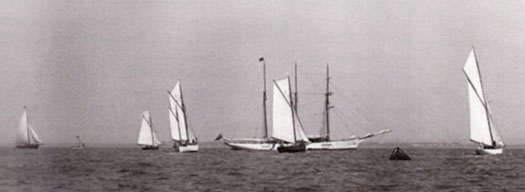
With the seven boats in the first Fastnet Race in 1925 having to beat eastwards out of the Solent from the start at Ryde, it was Gull (right) with her large sail area which soon showed ahead after making a good start. She was to lead for the first third of the 630 mile race.
In fact, Gull had the best of a fairly leisurely start off Ryde heading east out of the Solent on August 15th 1925. The Donegan cutter had much the most modern hull in the entire Fastnet flotilla, and with her huge if demanding rig, she was fastest in anything up to Force 4.
Thus she led by a good margin going outwards past the Scillies, but with sailing power soon lessened through broken topsail halyards, the succeeding stages weren't so happy, and the bigger Jolie Brise was first to the Fastnet with time in hand on the Irish boat. Heading back towards Plymouth in a freshening south'wester with the lee rail under, Harry Donegan updated his log on August 20th:
"The cabin swing-table is doing its level best to assassinate me. I have been struck in the chest and chin, while the weighty box beneath is making frantic efforts to amputate one or both of my legs"
A slight navigational error brought Gull in close north of Land's End in poor visibility, and by the time she'd made good this mistake in strong onshore winds, Jolie Brise – which was allowing her 9 hours on handicap – was well into Plymouth as the winner, while second went to the Royal Engineer's determinedly-sailed 38ft gaff cutter Fulmar, with Gull third.
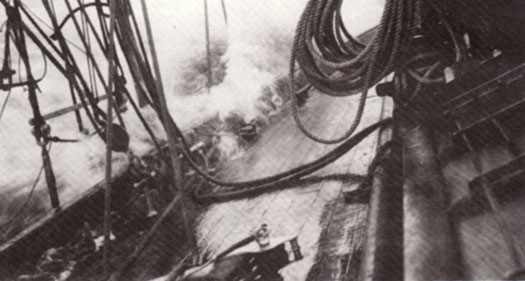
Gull making knots in the open ocean, headed for Plymouth from the Fastnet on August 20th 1925. Up-dating his log, Harry Donegan wrote: "the cabin swing-table is doing its best to assassinate me...."
Those accustomed to more recent Fastnet Races and the carnival atmosphere in the huge fleet at the finish will be intrigued by the picture Harry Donegan conveyed in the Autumn of 1925, responding to a letter from Weston Martyr, about the atmosphere which prevailed in that tiny first Fastnet flotilla as they lay to their anchors in Plymouth:
Cork, 12th November 1925
"I was exceedingly glad to get your breezy letter which was redolent of the salt sea, and may I say here that if my crew favourably impressed you, you in turn made a very lasting impression upon us all, short though our opportunities were for sizing each other up. I must say, further, that we were all appreciative of the excellent type of sportsmen that now go to constitute the Ocean Racing Club.
Take, for instance, these boys in the Fulmar. Under ordinary circumstances we, as traditional Irishmen, should have been in their wool after the finish, yet we all fell around each other's necks with the true spirit of comradeship and made merry on both ships.
Martin, needless to say, shines out as a most excellent type. We were particularly pally with the crew of Jolie Brise later, and doubtless had North Star and Banba moored near Drake's Island, we would all have fraternized in the same way.
I have raced a good deal and know the petty little feelings that sometimes prevail after the finish of an ordinary race. If one's boat has done excellently up to a point, and has then been pipped by horrible ill-luck, sometimes there is not a superabundance of joy.
Contrast that with the congenial assembly in Plymouth, and do you not share with me the impression that the Ocean Race has merits beyond the most optimistic hopes of the originators, in that it brings out the best in us and creates a feeling of good fellowship amongst the competitors that no other class of racing is calculated to do so thoroughly and effectively."
With the race successfully launched, the new Ocean Racing Club at its first formal meeting in October 1925 considered ways changing the course to make it of greater interest to yachts based outside the Solent-Plymouth nexus, but Harry Donegan was having none of it, and in writing to Weston Martyr he did much to ensure that the classic Fastnet Race was kept in place:
"I do not see how the Committee are ever going to change the course, that is if they want to stick to the 600 miles, and I confess I cannot at all see how they can ever improve on it. There is ocean sailing enough to satisfy a glutton, a freedom from sand banks, and only good honest rocks to think about."
Nevertheless we have to remember that back in the late 1920s and early 30s, it took real determination to keep it going at all, first as an annual event, and then after 1931 as biennial. Certainly there were those for whom, having done the first race of 1925, doing it again was of no interest. But Harry Donegan was one of those who considered participation in the 1926 race was essential, even if he was now 56 years old and no longer in the best of health.
The fact that he willingly took Warwick Tompkins aboard as a last-minute addition to the crew also suggests that he may have had difficulty in assembling a full ship's complement back home. And the race was now acquiring further contentious issues. There were those who still said it shouldn't happen at all, but others were so enthusiastic that boats were being purpose built for the Fastnet Race. A wealthy Scot, Norman Baxendale, had commissioned William Fife to design and build a Bermudan rigged cutter which would exactly fit the Ocean Racing Club's new upper limits of LOA70ft, and LWL50ft.
This was Hallowe'en, which was such a mighty leap forward in the concept of what constituted an ocean racer that most of the old salts considered her plain unsporting. We know Hallowe'en so very well now, for after an adventurous life on both sides of the Atlantic, she has been restored and is currently owned by an Irish syndicate who from time to time base her at the Royal Irish YC in Dun Laoghaire, though perhaps from respect for her history, the home port inscribed on her elegant counter is Cork.
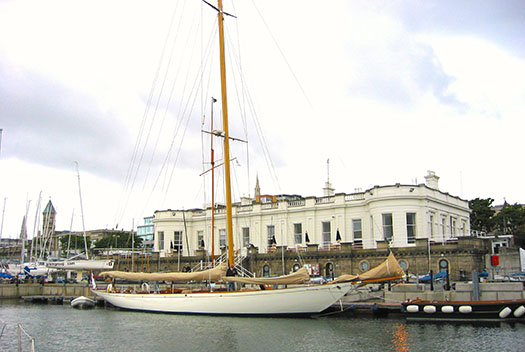
The 70ft Fife cutter Hallowe'en, which set a course record for the Fastnet Race in 1926 which stood for 13 years, and was only bested by an 88-footer. Hallowe'en is seen here at the Royal Irish YC in Dun Laoghaire, and is owned by a syndicate of RIYC members. Photo: W M Nixon
But back in 1926, with a fleet of eight boats racing the second Fastnet, Hallowe'en was so much on her own that despite some strong winds as she came in past the Lizard heading for the finish, she experienced little of the southeast gale which created mayhem out at the rock, with some boats hove to for a day and more, and Gull – which had been doing rather well, third on the water at the rock – eventually making her dramatic exit towards Cork Harbour in the intense little local low which blasted the smaller boats.
Hallowe'en established a course record which stood until 1939, by which time even larger boats were allowed to compete, and her time was bested by the Kriegsmarine's 88ft Gruber yawl Nordwind, whose German naval crew did not endear themselves to the organisers by their exuberant use of full uniform and Hitler salutes at the prize-giving. In fact, it wasn't until Ted Turner's 12 Metre American Eagle zapped round in style in 1971 that the Hallowe'en course record was beaten by a boat of comparable size.
So back in 1926 she was sensational, yet in simply designing to the upper limits, William Fife took no other account of the developing RORC measurement rule, and Hallowe'en had a rating so stratospheric that she finished third on corrected time, the winner being the 20-ton yawl Ilex, sailed by those very determined Royal Engineers.
As for Harry Donegan and Gull, that was their last Fastnet participation, but they were regular contenders in other events., particularly the RORC Falmouth-Clyde races during the 1930s when the skipper's son Young Harry was becoming involved, and of course the skipper himself was involved with huge and infectious enthusiasm for the Irish Cruising Club from its formation in 1929. In the end, passage races to West Cork and cruising that incomparable area became his fulfilling pleasure, and he'd a final magnificent sail from Schull back to Crosshaven before his death in 1940, aged 70.
His son Young Harry took up the reins, and in 1946 he sold Gull to England, and replaced her with the much racier Fife-designed Sybil from within the Cork Harbour fleet. 1947 was to be the first full year with the new boat, and he took her round to Dublin Bay for the Dun Laoghaire to Clyde Race, but tragically he was drowned when the dinghy filled in a near gale in Dun Laoghaire Harbour while returning aboard from the pre-race briefing. Like his father, Young Harry was a teetotaler, but in his tireless efforts to save his shipmates, he became exhausted and was the only one of Sybil's crew lost in this accident which reverberated sadly through Irish sailing for decades.
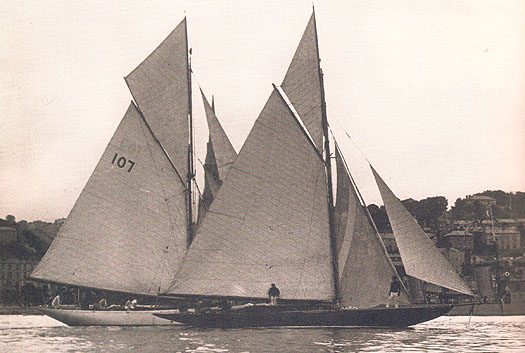
The two yachts which brought triumph and tragedy to the Donegan dynasty – Gull and Sibyl off the Cobh waterfront during the 1930s. Photo courtesy Royal Cork YC
Young Harry's eldest son Jim then became head of the clan although still only a schoolboy, but over the years he showed the family's zest for offshore racing and successfully competed in many major events in a variety of craft. And in the best family traditions, he was also busy behind the scenes becoming a founding Commodore of the South Coast Offshore Racing Association, and then a co-founder (with Fintan Cairns) of the Irish Cruiser Racing Association in 2002.
We are now five generations down the Donegan line from the great Harry P F Donegan himself, and the current most visible carrier of the torch is his great-great-grandson Jamie Donegan, who is the very highly regarded bow-man aboard Anthony O'Leary's new boat, the red Ker 40 Antix, where the Donegan contribution to winning the recent British IRC Championship was particularly noted.
As for his extraordinary great-great-grandfather, he was the man whose crisp opinion on the attractions of the Fastnet course may well have been the key to its lasting appeal. And with every passing year, his very special and innovative contribution to Irish and international sailing and the development of offshore racing and proper cruising is more fully appreciated
Harry Donegan was rightly and fondly remembered by many, not least his former shipmate Warwick Tompkins. After Gull's enforced retirement from the 1926 Fastnet Race, the skipper worked out that if they caught that night's Cork-Fishguard ferry and had a bit of luck with train timetables in south Wales and southwest England, he might just be able to get Tomkins to Plymouth in time for the Fastnet Dinner in the Royal Western.
They made it by the skin of their teeth. And at the dinner, Harry Donegan made such an impassioned little speech about the contribution his new friend had made to the saving of the Gull that his fellow members of the Ocean Racing Club waived their normal insistence on completion of the Fastnet Race as being the requirement for membership of their club. Warwick Tompkins was elected to the ORC, soon to be the RORC, with acclamation.
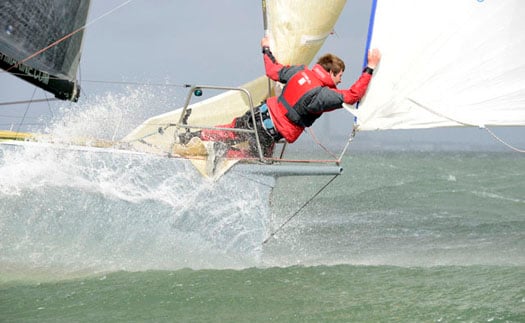
Doing that Donegan thing....Jamie Donegan, great-great-grandson of Harry Donegan, busy at his work as bowman aboard Anthony O'Leary's Antix. Photo: Rick Tomlinson
#fastnet – "The Gull was a plank-on-edge cutter of ancient vintage. She had a tremendous jackyard topsail, a terrific tiller, and a pack of wild Irish men aboard her, who flogged the life out of her. As I recall, we were either first or second around the Fastnet. Shortly thereafter the mainsail started letting go and water came up over the floor-boards because we'd spewed all our bow caulking. The glass dropped .80 inches in forty-five minutes, and on that came a regular Bristol Channel howler."
Thus is Harry Donegan of Cork and the Gull's involvement in the Fastnet remembered, in this opening to a piece of international sailing journalism written after the second Fastnet Race of 1926 by Warwick Tompkins. He was an American who was so keen to do this recently inaugurated challenge that he inveigled his way into Gull's crew by what was virtually a pierhead jump shortly before the start.
But he and his skipper and new shipmates hit it off well, and subsequently his own seafaring career blossomed with his thirty years of voyaging aboard the schooner Wander Bird recorded in print and on film. His family were raised totally afloat, such that one of his sons, Warwick Jnr, was a renowned sailor invariably known as Commodore Tompkins who commented that his life had been lived back to front. Most sailing enthusiasts learn how to live on boats as they mature into an appreciation of cruising and the voyaging life. But Commodore Tompkins eventually had to learn how to live ashore, even though he continued sailing.
However, the name of Tompkins first came to sailing prominence through his father's vivid picture of Harry Donegan and his crew of Corkmen in the Gull in 1926. It says much for the power of Warwick Snr's writing that his account has the ring of a greater truth to it, despite the fact that it has certain inescapable inaccuracies. And we can rightly consider such things this morning as today in Cowes, Jamie Donegan (22) - great-great-grandson of Harry Donegan - is making final preparations with his shipmates aboard Anthony O'Leary's Ker 39 Antix to race his first Rolex Fastnet Race, sailing as bowman.
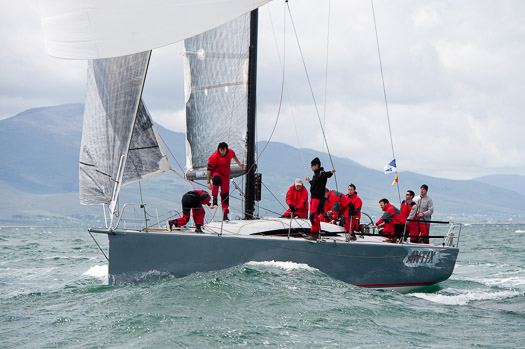
Anthony O'Leary Ker 39 Antix Photo by Bob Bateman
With a record fleet of 380 boats tomorrow – including a turnout of twelve Irish boats – the early Fastnet Races with their modest fleets have now acquired an almost mythological status. Each detail is lovingly picked over and analysed every which way, while the continuing and healthy survival of Jolie Brise, the 1913-built pilot cutter which won the first race of 1925, is a matter of awe. This was seen last month in Glandore was she was the superstar of the Classic Boat Regatta in this her Centenary year, with her ceremonial rounding of the Fastnet Rock a quasi-religious event.
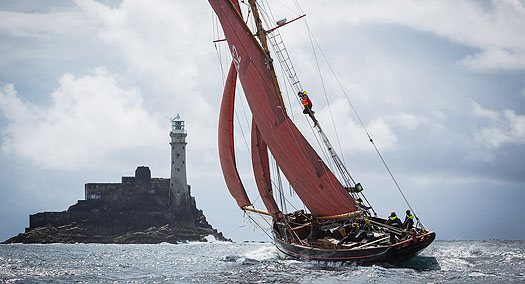
A very special event – the historic Jolie Brise, winner of the first Fastnet Race in 1925, approaches the Fastnet Rock in her Centenary Year during Glandore Classic Regatta last month. Photo: Brian Carlin
So what's the beef about old man Tompkins' Gull story? Simple enough. It's a slander on a fine yacht to describe her as "a plank-on-edge cutter of ancient vintage." She was no such thing. When Harry Donegan bought her in Cork Harbour in 1921, she was one of the shrewdest yacht-purchasing decisions ever seen about the place. For the handsome Gull had been designed in 1896 by the legendary Charles E Nicholson when he was aged 28, and starting to come into his prime as the greatest English yacht designer. Nicholson had been designing yachts of all sizes for construction by the family firm of Camper & Nicholson since at least 1892, and by 1896 he had moved very far indeed from the plumb bow, plank-on-edge leadmines of the 1880s.
With 10.1ft beam on her overall hull length of 44ft, many would have considered Gull quite beamy when she first appeared. But she did set a truly enormous gaff rig, and in order to hold it up the shrouds were given extra power by the chainplates being on channels to widen the angle. For stylish yachts in 1896, channels for the chainplates were rather old-fashioned, and for an American like Tomkins who associated such things with ancient working schooners, they gave a false impression of antiquity. But the fact is that at the time of the 1926 Fastnet, Gull was only thirty years old. Quite mature perhaps, but never "ancient vintage".
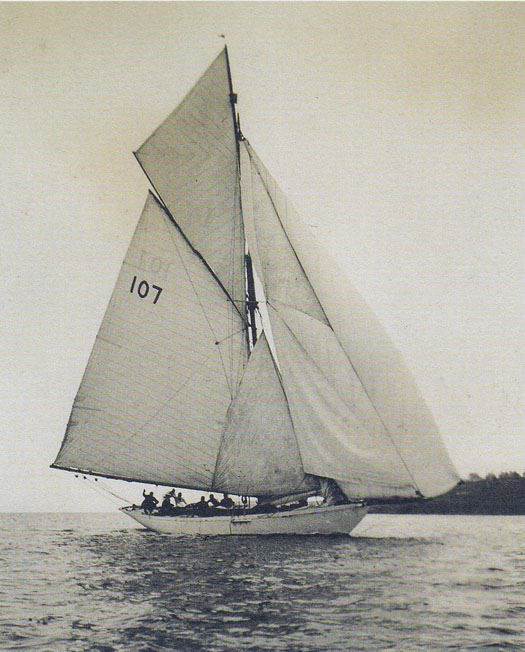
Gull in her prime. She was a fine creation by Charles E Nicholson when he was aged 28 in 1896, and beginning to make his mark as a major yacht designer. Photo courtesy Royal Cork YC.
Ironically, during the current Cowes Week, Jamie Donegan has been one of the "pack of wild Irishmen" sailing (and very successfully too) with Adam Gosling aboard the Corby 36 Yes!. Back in the day - and it's now quite a long time ago - the current Yes! was the ground-breaking Mustang Sally, first owned and campaigned with exceptional success by Peter Wilson of Howth. For many of us, Mustang Sally was and is the definitive Corby design, and it's great to see her today in superb order in loving ownership, and still in the frame. But the quite narrow Mustang Sally (as was) is now nearly twenty years old, comparable to Gull's age when Harry Donegan bought her when you also remember she'd been out of commission during the 14-18 War. Yet it would be absurd to describe Yes! as "a plank-on-edge sloop of ancient vintage".
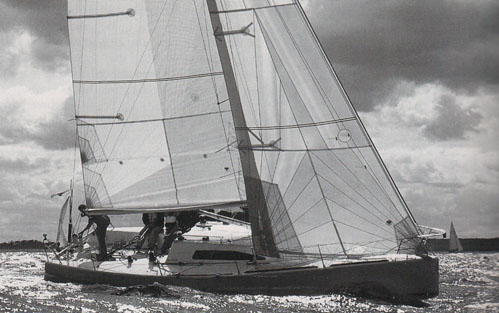
Mustang Sally in Peter Wilson's successful ownership. In June 1995 she won every race she entered, including (this photo) the Howth YC Centenary Regatta. Photo Rick Tomlinson/Courtesy HYC
That said, the huge rig on Gull took its toll which aged her before her time, and it gives us an excuse to run Warwick Tompkins' rollicking piece in full:
"The Gull was a plank-on-edge cutter of ancient vintage. She had a tremendous jackyard topsail, a terrific tiller, and a pack of wild Irish men aboard her, who flogged the life out of her. As I recall, we were either first or second around the Fastnet. Shortly thereafter the mainsail started letting go and water came up over the floor-boards because we'd spewed all our bow caulking. The glass dropped .80 inches in forty-five minutes and on that came a regular Bristol Channel howler.
In thick weather we groped for Baltimore, and when we got within what we estimated to be two miles and could not pick up the light, we reluctantly gave up the heroic idea of beaching the Gull there, caulking her, and still finishing. (Yes, that's the sort of Skipper and crew it was!) We hauled off to Queenstown (Cobh). We were close hauled under tri-sail and storm jib with the wind coming now from about the sou'east and the delightful Irish coast altogether too close under our lee.
The seas were breaching clean over the old packet, and the spitfire jib -- though we didn't know it—was pulling the runner eyebolt right out of the counter. We passed the Stag Rocks and they weren't more than two hundred yards to leeward; on the darkest, wildest sort of night they were plainly visible and audible, great and terrifying founts of spray just to leeward. It was possibly the closest escape I've ever had at sea and one of the few times my life has actually been in danger.
Well, the old bucket held together until we put her on the mud at Cobh in the morning. All hands had pumped bailed and cursed – I didn't hear any praying – all night long, and everything on board was soaked. When the mess was drying out in the sunlight this final morning I found my bedraggled, red-eyed, but still spunky little skipper fiddling around on deck with what looked to me suspiciously like a boy's toy. I asked him what he was doing, and his answer, s'helpmegawd, was:
"I'm flying a kite".
He went on to explain that he had meant to test out a theory that an aerial could best be carried by a kite when at sea, and so he had brought along a box-kite which he had forgotten until we started heaving gear on deck. Discovering it at this late date his intellectual curiosity remained strong enough to overcome the anxiety, desperate work and weariness of a rotten hard race and near-foundering. His name is Harry P.F. Donegan, a solicitor of Cork, and one of the world's best."
Corkmen will if course tell you that down Munster way, there's much more meaning to "flying a kite" than simply putting a toy aloft. And as for Harry Donegan being "one of the world's best", Warwick Tompkins had further reason for thinking so. In 1926, the only qualification for membership of the nascent but already prestigious Ocean Racing Club was completing a Fastnet Race. Harry Donegan and his crew were already members after coming third with Gull in the inaugural race the previous year. But that had been a relatively gentle affair, and Donegan reckoned that Tompkins was now every bit as qualified. So he gathered up the American, piled aboard the Cork-Swansea ferry that night with him, caught a series of trains to Plymouth next day, and that night at the post-Fastnet dinner, Donegan made an impassioned speech in support of Warwick Tompkins' right to RORC membership, which was carried with acclamation.
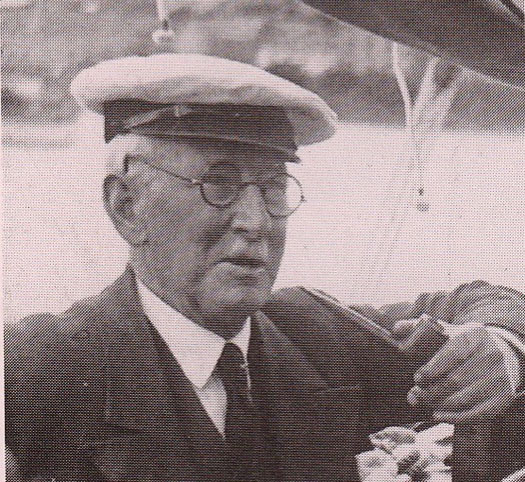
Harry Donegan aboard his beloved Gull
Harry Donegan (1870-1940) was in his way quite a force in sailing, and in the life of Cork and Ireland. A small man of notable energy, he was playing a key role in Cork Harbour sailing from an early age. When the plans for the new Cork Harbour One Designs were being discussed with William Fife in 1894-85, Donegan was secretary to the owners' group, and though he never owned a CHOD himself, he was renowned as helmsman in the class, and as an amateur painter he also recorded their earliest appearances.
But cruising and offshore sailing were his greatest passion, and he made some coastal ventures in very small craft. By 1912 he had produced pioneering harbour and anchorage plans for the magic places of West Cork, and this early interest in sailing directions was part of his enthusiasm for the notion of an Irish Cruising Club, though it was 1929 before he and a friend met while cruising west Cork, Billy Mooney of Howth, were finally able to bring the ICC into being.
In 1920, the Cork Harbour cruiser fleet acquired a handsome addition, the 18-ton Nicholson cutter Gull, bought in the southwest of England. For some reason, whoever brought her to Cork had to sell her the following year, and thus in 1921, Harry Donegan acquired his dreamship, the sailing love of his life.
These were difficult times in Ireland, with the country emerging from the War of Independence only to be plunged into the Civil War of 1922, fought over the acceptance or rejection of the Treaty which had ended the War of Independence. Initially, the anti-treaty forces had control of Cork, but as the summer of 1922 progressed, the Government's pro-treaty forces under the command of Emmett Dalton gradually closed in to free the southern capital.
Communications between Dalton and his commander Michael Collins in Dublin were becoming increasingly difficult as roads, railways and telegraph lines between the two cities were disrupted by anti-treaty guerilla groups. A system had been worked out whereby communications between Dalton and Collins were carried personally by Collins' feisty sister, Mary Collins-Powell. But when all usual means of getting her to Dublin with the vital dispatches were finally gone, Harry Donegan offered to sail her aboard Gull to Rosslare Harbour, where the east coast railway was firmly under government control all the way to Dublin.
For this venture in early August 1922, he assembled a crew of many professional talents. Harry Donegan was a solicitor, his first mate was Dr Gerald Ahern the local doctor, and in their sailing and any spiritual needs, they were helped by the third crewman, Fr Donal Murphy O'Connor.
Easterly winds hampered their progress towards Rosslare, but fortunately Government-controlled Waterford offered taxi communication with Rosslare, so they peeled off into port and soon the dispatches were in Dublin and Gull cruised back to Crosshaven. With the situation clarified for the general staff in Dublin, plans could be finalized for the freeing of Cork, and Emmett Dalton and his men soon had the job done.
Which was just as well for our three heroes on the Gull. While the city may have been coming rapidly under Government control, down to the south the countryside was still full of anti-treaty units. It was Civil War in all its horror of brother against brother, friend against friend. When the crew of Gull came ashore in Crosshaven after their successful little voyage, they were promptly captured by a local anti-treaty group, and imprisoned for some days in a shed.
But up in Cork, Emmett Dalton and his fellow commanders were going about their business with such efficiency that in Crosshaven the solicitor, doctor and priest - sailors all - were soon released unharmed. Peace returned to Cork Harbour. But as the main theatre of the Civil War moved ever more remorselessly towards its bloody denouement in West Cork, Michael Collins felt he could no longer be up in Dublin, remote from events in his home county. Despite everyone else advising against it, he came to Cork to be with his men. He spent his final night in the Imperial Hotel in Cork, and with that city already showing signs of its civilized normality, who knows but he may have had time to meet up with Harry Donegan, for everyone in Cork knew everyone else, then as now.
Next day, the Commander-in-Chief headed west on his tour of inspection, and by evening General Collins was dead, killed during a spirited exchange of fire in which he personally got involved following an ambush by men who would have been his comrades-in-arms during the War of Independence.
The Civil War was already being won by the pro-Treaty forces, but the death of Collins undoubtedly speeded its ruthless conclusion. By 1923, Ireland was very determinedly getting back to normality. In its own way, sailing made its contribution. In Dublin, self-taught yacht designer John B Kearney started construction on his masterpiece, the 38ft yawl Mavis. From Foynes on the Shannon Estuary, Conor O'Brien departed in his 40ft Saoirse – newly-built to his own design in Baltimore, West Cork - to sail to Dun Laoghaire to begin what was to become his epic pioneering voyage, round the world in two years south of the great Capes.
And in Crosshaven, Harry Donegan kitted out the Gull to make a long cruise to the west coast of France which so clearly demonstrated the yacht's speedy sea-keeping ability that when, in 1924, the notion was being aired of the new 630 mile ocean race from the Solent out to the Fastnet Rock, then back to a finish at Plymouth, Harry Donegan became one of its most enthusiastic proponents.
In that first race, the sailing establishment in Cowes wanted nothing to do with this contentious new challenge, so it was started eastward out of the Solent from Ryde. It was 1926 before the Fastnet was accepted by the RYS for the "traditional" westward start from Cowes, a point often forgotten in comparing record times, as the first race was about twenty miles longer. Be that as it may, Gull was one of the seven starters, and though she was by no means the newest (Jolie Brise was only a dozen years old), Charles E Nicholson had done his work well. Gull had much the most modern hull in the entire Fastnet flotilla, and with her huge if archaic rig, she was fastest in anything up to Force 4.
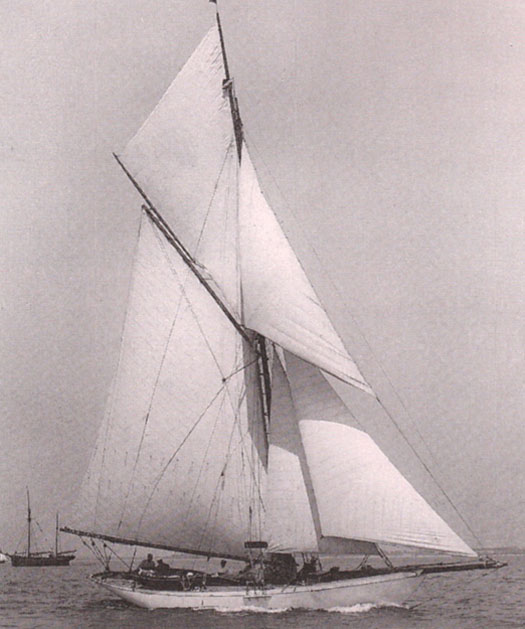
Gull at the start of the first Fastnet Race, August 15th 1925. She led overall for the first third of the race
Thus she led by a good margin going outwards past the Scillies, but with sailing power soon lessened through broken topsail halyards, the succeeding stages weren't so happy, and Jolie Brise was first to the Fastnet with time in hand on the Irish boat. Heading back towards Plymouth, a navigational error brought Gull in north of Land's End in fog, and by the time she'd made good this mistake in strong onshore winds, Jolie Brise – which was allowing her 9 hours on handicap – was well into Plymouth the winner, second went to the Royal Engineer's determinedly-sailed 38ft gaff cutter Fulmar, and third was Gull.
These days with talk (God forbid) of making the Fastnet an annual event as it is clearly so popular, we have to remember that back in the 1920s and early 30s, it took real determination to keep it going at all, first as an annual event, and then after 1931 as biennial. Certainly there were those for whom, having done the first race of 1925, doing it again was of no interest. But Harry Donegan was one of those who considered participation in the 1926 race was essential, even if he was now 56 years old and no longer in perfect health.
But the fact that he willingly took Warwick Tompkins aboard as a last-minute addition to the crew suggests that he may have had difficulty in assembling a full ship's complement back home. And the race was now acquiring further contentious issues. There were those who still said it shouldn't happen at all, but others were so enthusiastic that boats were being purpose built for the Fastnet Race. A wealthy Scot, Norman Baxendale, had commissioned William Fife to design and build a Bermudan rigged cutter which would exactly fit the Ocean Racing Club's new upper limits of LOA70ft, and LWL50ft. This was Hallowe'en, such a mighty leap forward in the concept of what constituted an ocean racer that most of the old salts considered her plain unsporting.
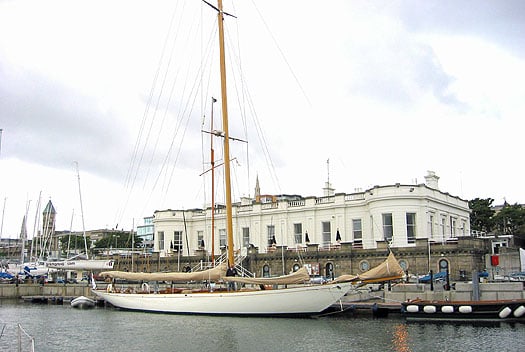
Hallowe'en, course record setter in the 1926 Fastnet Race, at the Royal Irish YC in Dun Laoghaire. Photo: W M Nixon
We know Hallowe'en so very well now, for after an adventurous life on both sides of the Atlantic, she has been restored and is currently owned by an Irish syndicate who from time to time base her at the Royal Irish YC in Dun Laoghaire, though perhaps from respect for her history, the home port inscribed on her elegant transom is Cork. But back in 1926, with a fleet of eight boats racing the second Fastnet, Hallowe'en was so much on her own that despite some strong winds as she cam in past the Lizard heading for the finish, she experienced little of the southeast gale which created mayhem out at the rock, with some boats hove to for a day and more, and Gull – which had been doing rather well, third on the water at the rock – eventually making her dramatic exit towards Cork harbour.
Hallowe'en established a course record which stood until 1939, by which time even larger boats were allowed to compete, and her times was bested by the Kriegsmarine's 88ft Gruber yawl Nordwind, whose German naval crew did not endear themselves to the organizers by their exubernant use of full uniform and Hitler salutes at the prize-giving. In fact, it wasn't until Ted Turner's 12 Meter American Eagle zapped round in style in 1971 that the Hallowe'en course record was beaten by a boat of comparable size. So back in 1926 she was sensational, yet in simply designing to the upper limits, William Fife took no other account of the developing RORC measurement rule, and Hallowe'en had a rating so stratospheric that she finished third on corrected time, the winner being the 20-ton yawl Ilex, sailed by those very determined Royal Engineers.
As for Harry Donegan and Gull, that was their last Fastnet participation, but they were regular contenders in other events, particularly the RORC Falmouth-Clyde races during the 1930s when the skipper's son Young Harry was becoming involved, and of course the skipper himself was involved with huge and infectious enthusiasm for the Irish Cruising Club from its formation in 1929.
In the end, passage races to West Cork and cruising that incomparable area became his fulfilling pleasure, and he'd a final magnificent sail from Schull back to Crosshaven before his death in 1940, aged 70. Death was with the Donegan family again all too soon, for after the war, Young Harry bought one of Cork Harbour's swiftest cruisers, the Clyde 30 Sybil. Gull was sold to the south of England where she ended her days, reportedly as a hulk in Poole Harbour. But with the exciting Sybil, the Donegan offshore racing tradition was hoped to continue, and in 1947 Young Harry and his crew brought her round to Dublin Bay for an ICC offshore race to the Clyde.
The pre-race briefing and party was in the National YC. Like his father, young Harry was a teetotaler, so he was mindful of his crew's safety as the wind was rising, and Dun Laoghaire's open harbour could be dangerously choppy for a dinghy. It proved tragically so. As they were struggling back to Sybil, the dinghy filled, and though Young Harry was heroically successful in ensuring the saving of all his shipmates, his efforts were such that he himself became exhausted, and drowned.
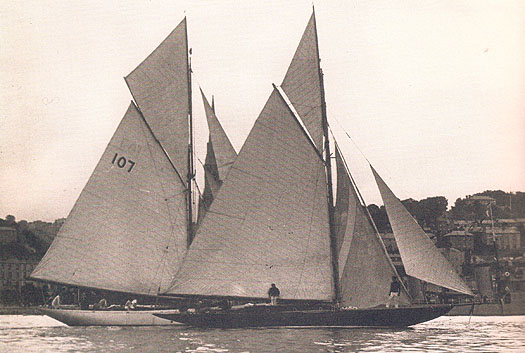
Gull (left) with the Sybil, which Young Harry Donegan bought when he sold Gull to England in 1946. Photo: Courtesy RCYC
It was a massive blow for all Irish sailing, and particularly for the Irish Cruising Club and the closely inter linked sailing community in Cork. But gradually the Donegan inspiration re-asserted itself, and the surname came to the fore in offshore racing again with the late Jim Donegan. Son of young Harry, and grandson of Henry P F Donegan, his successes with the Scampi Half Tonner Yellow Devil (with the Donegan sail number 107), the 36ft White Rooster, and lastly with the First 32s5 Mischief, put the Donegan name firmly back on the trophy boards, while in sailing administration he was the prime mover in founding SCORA (South Coast Offshore Racing Association) and, most importantly of all, in 2002 he became the first Commodore of the new Irish Cruiser Racing Association, which he founded with Fintan Cairns of Dun Laoghaire – it's now one of the most successful bodies not just in Ireland, but in offshore racing worldwide.
But now, there are many Donegans descended from the great Harry Donegan, and several of them sail. Just the same, it is quite something for young Jamie Donegan to be sailing down the Solent tomorrow on Antix, knowing that he is taking part in a globally significant event which his great-great-grandfather was instrumental in founding 88 years ago.
But in fairness, the entire Irish offshore racing community has done its bit in honouring the memory of Harry Donegan and the Gull by racing in the Fastnet as often as possible. Few more so than Denis Doyle with Moonduster, whose childhood memories of visiting the Donegan household on winter Sundays included being put to work with a junior group sanding the many wooden blocks necessary to keep Gull's huge rig under comntrol.
Then there have been other highlights such as the Irish Admirals Cup almost winning in 1979, and Ken Rohan's Regardless winning Class 1 in 1981, and Irish Independent recording the overall win in 1987 when the Admirals Cup team also notched a very creditable fourth.
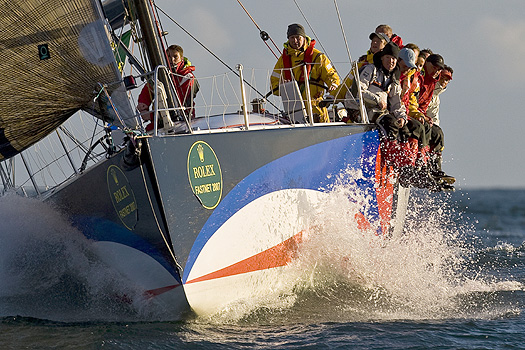
Ger O'Rourke's Cookson 50 Chieftain from Kilrush sweeps in to Plymouth to win the 2007 Fastnet Race overall in convincing style.
But in the long history of the race, the supreme Irish moment has to be Ger O'Rourke's clear overall win with Chieftain in 2007. Like the rest of us, life has had its ups and downs for Ger since 2007. But that glorious supreme win is one of the greatest highlights of Irish sailing history.
So with a dozen Irish boats in the pot this year, who can we expect to figure in the final listings? Defending holder of the Gull Salver for the best-placed Irish boat in the Fastnet is the J/133 Spirit of Jacana from Carrickfergus, campaigned by the Douglas brothers, and they're going again. Much will also be expected of Antix, as her skipper is an RORC Flag Officer, and she's a proven winner. And though the Galway Reflex 38 sometimes known as Lynx has had a mixed season, over a series of events including the ICRA Championship and the Sovereigns her overall performance has been tops.
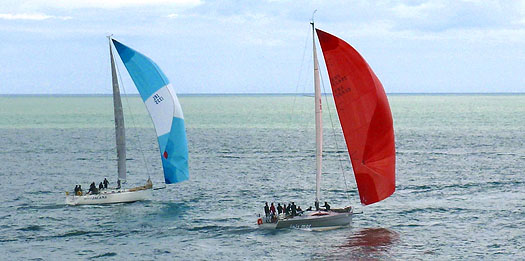
Spirit of Jacana and Inis Mor in the Round Ireland Race 2012. Both are comppeting in tomorrow's Fastnet Race. Photo: W M Nixon
More important with every year in the RORC programme is the two-handed division, and here we have a very strong interest with Andy Boyle of Dun Laoghaire who sails with Nick Martin on the J/105 Diablo-J. They won the Round Ireland Race in this division last year, and they've been right in the frame throughout this year's programme – very much a boat to watch in a division in which the competition will include young David Kenefick of Crosshaven and Olaf Sorensen of Kinsale in the Figaro II.
But with 380 boats making their westward out of the Solent tomorrow, it's anybody's guess for the class wins as much as the overall titles. So taking them alphabetically is as good as sticking in a pin hile blindfold, and here are the boats with special Irish interest, good luck to all of them.
Adelie (First 34.7, Peter Hall, NYC)
Alchimiste (JPK 9.60, Mike Murphy, KYC)
Antix (Ker 39, Anthony O'Leary, RCYC)
Aquelina (J/122, James & Sheila Tyrrell, Arklow SC)
Figaro II (Figaro, David Kenefick RCYC)
Diablo-J (J/105, Nick Martin/Andy Boyle, RORC)
Inis Mor (Ker 39, Laurent Gouy, Clifden BC),
Jedi (J/109, Andrew Sarratt, Dun Laoghaire)
Joker (J/109, Chris Andrews, Dun Laoghaire)
Lula Belle (First 36.7, Liam Coyne, NYC)
Lynx Clipper/The Gathering (Reflex 38, Aodhan Fitzgerald, GBSC),
Spirit of Jacana (J/133, Alan, Bruce & James Douglas, Carrickfergus SC.
Tonnere de Breskens (Ker 46, Piet Vroon, RORC)
Irish Team Ready for Student Yachting World Cup
Yesterday marked the beginning of the 30th Student Yachting World Cup (SYWoC), and for the Irish Team, it was the first opportunity for some of them to check out La Rochelle. This year's Team Ireland consists of a joint effort between UL, LIT and UCC.
The team consists of Skipper Robert O'Leary(UCC), Cian Gallagher (UL), John Blake (UL), Dee O'Rourke (LIT), Lisa Dann (UCC), Caitlin Cuppage (UCC), Shane Newman (UL), Peadar O'Suilleabhain (UL), Jamie Donegan (UCC). The team will race with 6 or 7 up depending on the weather for the week, currently the forecast is looking quite light. Not what was expected for this time of year in La Rochelle.
After an early start at 7am this morning, the team travelled to the Societé de Regatis Rochelouies, the club which hosted the very first SYWoC in 1979. And which is SYWoC's base for the week.
A practice race was scheduled for 2pm, after a general briefing at 1pm. However, with wind gusting over 30kts, the race organisers decided that it was not worth risking the fleet with 6 days of racing ahead. The teams will be given an hour prior to racing tomorrow to put the final preparations on their 2010 SYWoC campaigns.
Team Ireland will hope to keep the title of a force to be reckoned with, after all the past 4 SYWoC campaigns for Ireland have had results of a 1st (Trinity - 2006), 2nd (CIT - 2007), 1st (CIT - 2008), 4th (CIT - 2009).





























